|
|
|
|
|
Iridex's Patented MicroPulse® Laser Therapy
MicroPulse allows the tissue to cool between laser pulses, minimizing or preventing tissue damage. Treatment risks are reduced or eliminated, with increased patient comfort than with conventional, continuous-wave laser treatment. 
|
|

MicroPulse® laser therapy is a tissue-sparing solution for the treatment of retinal diseases and glaucoma. With MicroPulse, a continuous-wave laser beam is chopped into a train of short, repetitive, low energy pulses separated by a brief rest period which allows the tissue to cool between laser pulses.
MicroPulse laser therapy is an essential asset for a comprehensive practice. We invite you to watch our webinars or to read this article from MicroPulse experts Drs. Friedrichs, Phillips, and Mahootchi to learn the reasons and benefits of incorporating MicroPulse into your practice.
Glaucoma
Introducing the New MicroPulse P3® Glaucoma Device (MP3) that performs innovative Cyclophotocoagulation with MicroPulse Technology Powered by the New CYCLO G6™ Glaucoma Laser System.
Learn How
MicroPulse laser trabeculoplasty (MLT) is a tissue-sparing laser therapy intended to reduce intraocular pressure. Unlike conventional laser trabeculoplasty procedures, there is no destructive, coagulative damage to the trabecular meshwork.
Learn How
Retina
MicroPulse settings extend the aspects of tissue-sparing applications to treatments otherwise performed with conventional photocoagulation. DME, CSR, and even PDR are areas where MicroPulse laser therapy can be utilized.
Learn How
MicroPulse® is a laser delivery modality that adds fine control of photothermal effects in laser photocoagulation. In conventional photocoagulation, the temperature rise for an intended intraoperative endpoint is controlled by adjusting the power and the exposure duration of the continuous-wave (CW) laser emission.
With MicroPulse, the steady CW emission is "chopped" into a train of short laser pulses, whose "width" ("ON" time) and "interval" ("OFF" time) are adjustable by the surgeon. A shorter MicroPulse "width" limits the time for the laser-induced heat to spread to adjacent tissues, thus providing fine control of energy delivered. A longer MicroPulse "interval" between pulses allows cooling to take place before the next pulse is delivered.

MicroPulse (low duty cycle). Very little thermal spread can occur due to the extended "OFF" time between each MicroPulse. Tissue is allowed to return to baseline temperature before the arrival of the next pulse.

MicroPulse (medium duty cycle). Doubling the "width" of the pulse, doubles the energy deposited, increases the heat spread during the "ON" time, reduces the cool off time, but can still avoid cumulative thermal build-up.

MicroPulse (high duty cycle). More energy is deposited with more thermal spread during the “ON” time and some thermal build-up due to the shorter cool off time before the next pulse.

CW Pulse (100% duty cycle). The thermal rise and re-equilibration can only be controlled by adjusting the power and the exposure duration of the CW laser emission.
 |
|
With Continuous-Wave and MicroPulse® Modes, the Iridex IQ 577TM Laser Provides Uncommon Versatility
Gaurav Singh, MD
 Download Now Download Now
|
 |
|
MicroPulse® Laser Therapy Reduces Injection Burden in PDR With Chronic Diabetic Macular Edema
Jason Friedrichs, MD, MS
 Download Now Download Now
|
 |
|
Long-term Durability of MicroPulse® Laser Therapy for Diabetic Macular Edema in a Noncompliant, Monocular Patient
Kapil M. Sampat, DO
 Download Now Download Now
|
 |
|
MicroPulse® Laser Therapy as an Adjunct to Intravitreal Triamcinolone for Chronic Recurrent Idiopathic Cystoid Macular Edema
Margaret Wong, MD
Robert Halpern, MD
 Download Now Download Now
|
 |
|
BRVO Case Illustrates Safety and Efficacy of MicroPulse for Fovea-Involving Macular Edema
Dr. Gossage discusses his case where MicroPulse resolved a patient’s center-involving macular edema.
David Gossage, DO, FAOCO, FAAO
 Download Now Download Now
|
 |
|
Striking Results Achieved with MicroPulse™ Laser Therapy in Patients with Persistent Central Serous Retinopathy
Gennady Landa, MD
 Download Now Download Now
|
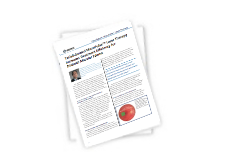 |
|
TxCell-Guided MicroPulse Laser Therapy Increases Treatment Efficiency for Diabetic Macular Edema
Johnny Tang, MD
 Download Now Download Now
|
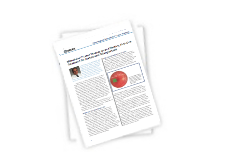 |
|
MicroPulse Laser Therapy as an Effective, First-Line Treatment for Juxtafoveal Telangiectasia
Sam Mansour, MSc, MD, FRCS, FACS
 Download Now Download Now
|
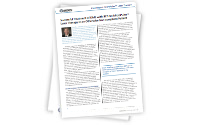 |
|
Successful Treatment of DME with 577 nm MicroPulse™ Laser Therapy in an Otherwise Non-compliant Patient
Case Study using IQ 577 with MicroPulse™ technology to treat 64 year old male with center-involving DME.
Jonathan D. Walker, MD
 Download Now Download Now
|
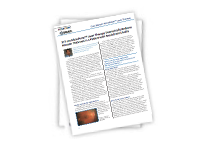 |
|
577 nm MicroPulse™ Laser Therapy Dramatically Reduces Macular Thickness in a Patient with Recalcitrant Uveitis
Jeevan Mathura, MD
 Download Now Download Now
|
 |
|
MicroPulse™ Laser Therapy and Anti-VEGF Injections for Macular Edema Associated with CRVO
Patrick Caskey, MD
 Download Now Download Now
|
 |
|
Combining Tissue-sparing MicroPulse™ Laser Therapy and Anti-VEGF Medication Produces Unprecedented Results in Radiation Retinopathy
MicroPulse is a laser energy delivery modality that enables fine control of the thermal effects of photocoagulation...
Timothy G. Murray, MD, MBA, FACS, FAAO
 Download Now Download Now
|
 |
|
MicroPulse Laser Therapy For the Treatment of DME
A less destructive laser may offer greater benefits for treating edema.
David D. Gossage, DO, FAAO, FAOCO
 Download Now Download Now
|
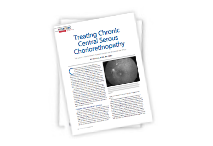 |
|
Treating Chronic Central Serous Chorioretinopathy
Michael Koss, MD, FEBO
 Download Now Download Now
|
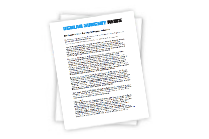 |
|
Subthreshold laser therapy yields good outcomes
Dr. Gossage shares his experiences using MicroPulse laser therapy to treat retinal and glaucoma disorders.
David D. Gossage, DO, FAOCO, FAAO
 Download Now Download Now
|
 |
|
DME - First Line Therapy - IQ 532™
Case study using IQ 532 with MicroPulse™ technology to effectively treat a 70-year-old patient with longstanding DM.
Aaron Appiah, MD
 Download Now Download Now
|
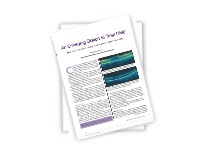 |
|
An Emerging Option to Treat DME
Two case studies using MicroPulse technology: 63-year-old white male with very aggressive refractiveDME & 80-year-old woman with DME in both eyes.
Aaron Appiah, MD
 Download Now Download Now
|
 |
|
DME Refractive to 6 Injections of Bevacizumab - IQ 532™
Difficult case of diffuse diabetic macular edema who received 6 monthly injections of bevacizumab with no results.
José A. Cardillo, MD
 Download Now Download Now
|
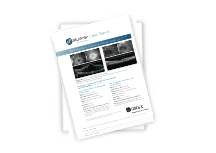 |
|
DME Refractive to 7 Injections of Bevacizumab - IQ 532™
Female patient with difficult case of diffuse DME who received 7 monthly injections of bevacizumab with no results.
José A. Cardillo, MD
 Download Now Download Now
|
 | | Outcomes of Micropulse Transscleral Cyclophotocoagulation in Uncontrolled Glaucoma Patients Glaucoma is the leading cause of irreversible blindness worldwide, with >70 million people affected and ~10% becoming legally blind during their lifetime. According to current evidence, glaucoma is defined as a group of optic neuropathies manifesting as progressive degeneration of the retinal ganglion cell layer, with consequent optic disc remodeling and cupping, and ultimately irreversible visual field loss. This study aimed at evaluating the intermediate-term efficacy and safety of micropulse transscleral cyclophotocoagulation (MP-TSCPC) in cases of uncontrolled glaucoma. |  | | Laser resensitization of medically unresponsive neovascular agerelated macular degeneration: Efficacy and Implications. Subthreshold diode laser micropulse was performed in 13 eyes unresponsive to all anti-VEGF drugs despite at least 4 consecutive anti-VEGF injections given for more than 4 to 6 months, including at least 3 consecutive ineffective aflibercept injections given 4 to 6 weeks apart. After monthly aflibercept was resumed 1 month after MicroPulse, 92% (12 of 13) of eyes improved, with complete resolution of macular exudation in 69% (9 of 13). Visual acuity remained unchanged. Central and maximum macular thicknesses significantly improved. Subthreshold diode micropulse laser treatment restored drug response in drug tolerant eyes with neovascular age- related macular degeneration.  Download Now Download Now
|  | | Subthreshold laser therapy for diabetic macular edema: Metabolic and safety issues A review of the literature about the mechanisms of action and role of MicroPulse diode laser in DME was conducted. The authors conclude that MicroPulse is a new, promising treatment option in DME, with both infrared and yellow wavelengths using the less aggressive duty cycle (5%) and fixed power parameters. It appears to be safe from morphologic and functional point of view in mild center involving DME.  Download Now Download Now
|  | | Long-term safety, high-resolution imaging, and tissue temperature modeling of subvisible diode micropulse photocoagulation for retinovascular macular edema A long-term retrospective review of 274 consecutive eyes with macular edema due to DME or BRVO that were treated with MicroPulse high density laser treatment using various duty cycles and followed for up to 10 years. Authors’ conclusions: High density MicroPulse laser treatment effectively treats retinovascular macular edema without laser-induced retinal damage  Download Now Download Now
|  | | Randomized clinical trial evaluating mETDRS versus normal or high-density micropulse photocoagulation for diabetic macular edema A prospective, double-masked, controlled clinical trial on 123 eyes with DME. Three dosing protocols were compared and patients were followed for a minimum of 1 year. Authors’ conclusions: High density MicroPulse treatment is superior to the mETDRS based on BCVA improvement and CMT reduction.  Download Now Download Now
|  | | Microperimetry and fundus autofluorescence in diabetic macular edema: subthreshold micropulse diode laser versus modified early treatment diabetic retinopathy study laser photocoagulation A prospective, randomized clinical trial on 62 eyes (50 patients) with untreated, center-involving, clinically significant DME, treated with either ETDRS or subthreshold MicroPulse laser therapy. Authors’ conclusions: High density MicroPulse laser is as effective as mETDRS laser in stabilizing visual acuity and in reducing macular edema with the benefits of no tissue damage detectable at any time point postoperatively, and of significant improvement in retinal sensitivity.  Download Now Download Now
|  | | Subthreshold diode laser micropulse photocoagulation versus intravitreal injections of bevacizumab in the treatment of central serous chorioretinopathy A comparative, controlled, prospective study comparing MicroPulse, intravitreal BCZ injection, and observation for the treatment of CSC in 52 eyes of 52 patients. Authors’ conclusions: Results indicate superior subretinal fluid resolution, and superior VA improvement and other visual functions, for MicroPulse laser compared to anti-VEGF injections, with no tissue reactions observed during and at any point after MicroPulse treatment.  Download Now Download Now
|  | | Subthreshold Diode Micropulse Laser Photocoagulation (SDM) as Invisible Retinal Phototherapy for Diabetic Macular Edema: A Review A review of the role and evolution of retinal laser treatment for DME, including the state-of-the-art of clinically effective and harmless subthreshold diode (810 nm) laser MicroPulse photocoagulation for the treatment of DME. Authors’ summary: The discovery of clinically effective and harmless SDM treatment for DME offers exciting new information that will improve our understanding of laser treatment for retinal disease, expand treatment indications, and improve patient outcomes.  Download Now Download Now
|  | | Nonvisible subthreshold micropulse diode laser (810 nm) treatment of central serous chorioretinopathy. A pilot study A prospective study of 24 eyes, with CSC for more than 3 months with no prior intervention, were treated with nonvisible MicroPulse laser. Mean follow-up was 14 months (mean, range 3 to 36 months). Authors’ conclusions: The majority of eyes achieved anatomic and functional improvements. MicroPulse is a new and promising method for treating a previously untreatable disorder. This minimally invasive and retina sparing treatment may allow the cure of CSC at its earlier stages when irreversible visual loss has not occurred  Download Now Download Now
|  | | Micropulse diode laser photocoagulation for central serous chorio-retinopathy A retrospective case series of 5 patients with CSC treated with MicroPulse. At 17.1 months (mean, range 6 to 24 months) follow-up, 4 of 5 patients had complete resolution of symptoms. Authors’ conclusions: Outcomes confirm long-term efficacy of MicroPulse in the management of CSC. It produces therapeutic effects that appear comparable to those of conventional PC with no detectable signs of laser-induced iatrogenic damage  Download Now Download Now
|  | | MicroPulse® Laser TherapyBibliography of Published Articles, Posters, and Podium Presentations  Download Now Download Now
|
|
|
Iridex MicroPulse® Laser Therapy for Macular Edema in Multiple Etiology: An Essential Asset for a Comprehensive Practice
Ahad Mahootchi, MD; Brandon Phillips, MD; Jason Friedrichs, MD, MS
|
 |
|
MicroPulse Laser Therapy in the Management of DME
Allen C. Ho, MD; Robert L. Avery, MD; Lawrence S. Morse, MD, PhD; Elias Reichel, MD
|
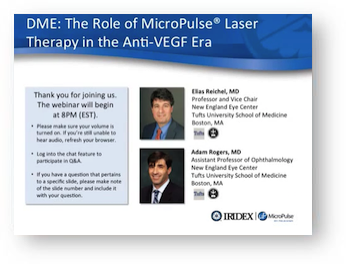 |
|
DME: The Role of MicroPulse® Laser Therapy in the Anti-VEGF Era
Drs. Elias Reichel and Adam Roders
|
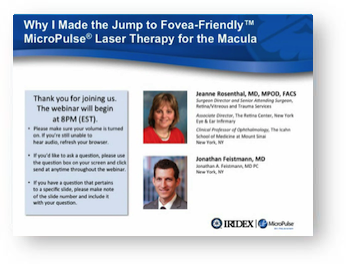 |
|
Why I Made the Jump to Fovea-Friendy MicroPulse Laser Therapy for the Macula
Drs. Jeanne Rosenthal and Jonathan Feistmann
|
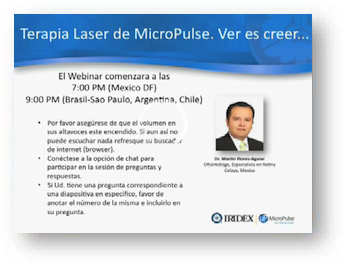 |
|
Terapia Laser de MicroPulse. Ver para creer...
Dr. Martin Flores-Aguilar
|
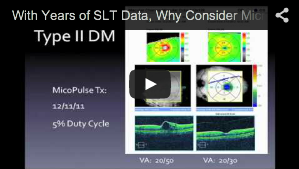 |
|
With Years of SLT Data, Why Consider MicroPulse?
Drs. Ike Ahmed, David Gossage, and Steven Vold
|
 |
|
MicroPulse™ for the Ultimate Skeptic: Seeing is Believing
Watch Now
|
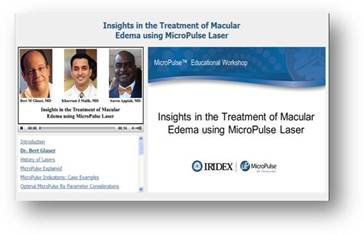 |
|
Workshop: Insights in the Treatment of Macular Edema using MicroPulse Laser
September 2012
Watch Now
|
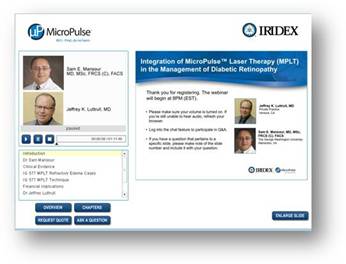 |
|
Webinar: Integration of MicroPulse Laser Therapy (MPLT) in the Management of Diabetic Retinopathy
May 2012
Watch Now
|
| |
|
The Clinical and Economic Argument for MicroPulse Laser in a Retinal Practice - Jorge Calzada, MD
|
| |
|
Management of Diabetic Macular Edema with MicroPulse Laser Therapy
|
| |
|
Iridex MicroPulse Educational Dinners
|
| |
|
European Glaucoma Society (EGS) Symposium: MicroPulse Therapy for Glaucoma Treatment
|
| |
|
MicroPulse, a new non-incisional procedure to treat glaucoma
|
| |
|
Dr. Charles Harris explains why he used MicroPulse laser to treat his mother's glaucoma
|
| |
|
MicroPulse P3 Procedure for Glaucoma: Beyond Late Stage
|
| |
|
MicroPulse CPC Glaucoma Treatment and Patient’s Profiles
|
| |
|
Updates from the MicroPulse Aqueous Dynamics Study in Early or Moderate POAG
|
| |
|
Iridex MicroPulse ESCRS 2018 Symposium Q&A
|
| |
|
With Years of SLT Data, Why Consider MicroPulse® for Treatment of Glaucoma?
|
| |
|
Webinar: Iridex MicroPulse® Laser Therapy for Macular Edema in Multiple Etiology
|
| |
|
Personalized Glaucoma Laser Therapy with the Titratable MicroPulse P3
|
| |
|
MicroPulse for DME: Treat What Other Lasers Can’t
|
| |
|
MP3 Treatment - Robert Noecker, MD
|
| |
|
MicroPulse for Glaucoma & Retina. What's the Hype?
|
| |
|
532 nm MicroPulse Laser Trabeculoplasty (MLT)
|
| |
|
MicroPulse Laser Therapy in Practice
|
|
|
|
*Bhagat N, Zarbin M, Mansour S, Chong V, and Cardillo JA. Fovea-friendly MicroPulse Laser. Supplement to Retina Today, May/June 2012
|
|
|